Hans Binnendijk and Daniel S. Hamilton
Set against the backdrop of Russia’s war on Ukraine, the June 2022 Madrid NATO Summit set the tone for the next decade of the Alliance’s shared future. Allies made it clear that they consider Russia their most immediate and direct threat. Yet they also made headlines by addressing challenges emanating from the People’s Republic of China (PRC). Allies laid out actions to be taken across the diplomatic, economic, and military spheres. Now the Alliance must implement those responses. Beijing will be watching closely.
I. China in transatlantic security relations
During much of the past decade, the United States and its NATO allies had diverse perspectives on the nature of the Chinese challenge. Many European countries relied heavily on trade with China and on Chinese investment, neglecting the dependencies and Chinese opportunities for coercion that those economic ties created. Most had no security obligations in Asia. The United States, on the other hand, had defense commitments to several Asian allies, which gave Washington a more complicated assessment of China’s challenges. Those differences were amplified by US President Donald Trump’s “America First” economic warfare with China.
It took Chinese behavior during the COVID-19 pandemic, human rights abuses in Hong Kong and Xinjiang, Chinese diplomatic and economic coercion in Europe, and enhanced Chinese security ties with Russia to generate a higher degree of transatlantic cohesion on the nature of the China challenge. NATO’s ability to address traditional and unconventional threats in Europe became intertwined with related challenges to Alliance security interests posed by China.1 These challenges include the following:
A. Chinese technological advances have a number of direct security implications for NATO
5G/6G infrastructures. Huawei’s emergence as a dominant fifth-generation (5G) telecommunications infrastructure supplier for many countries gives Beijing access to key parts of emerging communications networks, generating choke points of vulnerability for Allied nations. Within fifteen years, 5G is likely to be replaced by dual-use 6G technologies with embedded AI-enabled capabilities of military significance. China is likely to incorporate them into its civil-military fusion strategy, as it has with 5G.2
Defense-relevant technologies. Beijing is seeking technological dominance in command, control, communication systems, and computers (key for political and military decision-making); intelligence, surveillance, reconnaissance (key for situational awareness); logistical and digital cyber systems (key for deployment of forces and military operations across all domains); and artificial intelligence (key for long-term competitiveness in unmanned systems, C4ISR, and novel operational concepts).China’s civil-military fusion strategy leverages investments in traditionally civilian sectors to enhance development of its military and emerging disruptive technologies.
Quantum technologies. Beijing is developing quantum technology with military applications in sensing, communications, and data processing. As China advances a national strategy for military-civil fusion, its advances in quantum science could affect the future military and strategic balance, perhaps even enabling it to leapfrog traditional US military-technological advantages. Universal fault-tolerant quantum computer capacities in Chinese hands could render Alliance encryption systems hackable.3
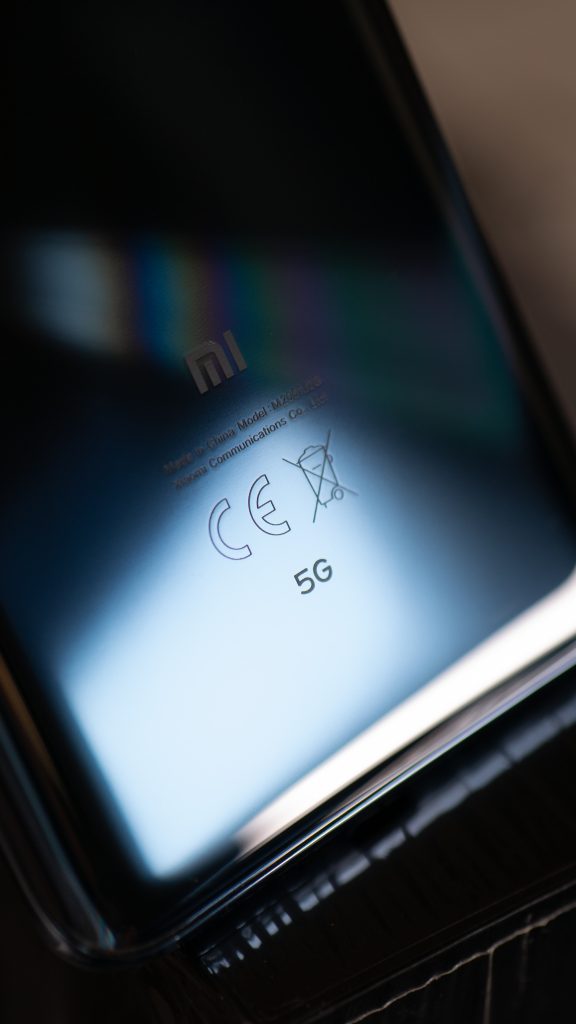
5G capable phone
Photo by: Shiwa ID via UnSplash
Cyberattacks. Beijing has the ability to tap into dataflows via intercontinental and interregional cables. It has used China Telecom’s presence in North America and Europe to hijack data traffic through Chinese servers. The challenge is likely to grow: use of AI in cyberattacks is likely to enable malware to adapt to countermeasures and security controls more rapidly than human-centered systems.
Splinternet. China, through Huawei, is proposing a New Internet Protocol that is nothing less than an attempt to set the rules and design the architecture of a new internet. New IP would bake authoritarianism into the architecture underpinning the web and give state-run internet service providers granular control over citizens’ use.
Power projection. China’s military rise is starting to match its economic ascent. Over the past decade, its defense budget has grown significantly and it has embarked on an ambitious process of military modernization using its cutting-edge technologies. Currently a regional military power that pursues a variety of hybrid tactics in its maritime disputes with many of its neighbors, it will be able to increasingly project extraregional power in the next decade.4
B. European and North Atlantic security can be impaired by dangerous dependencies
Those dependencies are created by Chinese investments in European infrastructure and technologies, including strategic ports, telecoms, power grids, defense-related supply chains, and extreme reliance on China for rare earths and critical materials. Beijing has instrumentalized these dependencies in the past. Moreover, China’s connectivity strategies, including through its Belt and Road Initiative (BRI), are not only intended to extend supply chains and logistics routes but also to create conditions to advance Chinese standards, practices, and digital flows. More than half of NATO allies have signed BRI-related agreements. Those dependencies can affect European decision-making and Alliance operations in time of crisis and/or conflict.5
C. China’s maritime claims, its space policies, its manipulation of information, and its activities in the Arctic could threaten key principles of the global commons
Those claims could be further accentuated by Beijing’s efforts to erode the East Asian regional order.6
Freedom of the seas. In the South China Sea, China’s maritime claims and gray-zone dominance activities have restricted the ability of its neighbors to access resources in their own waters in contravention of international law. Most of Europe’s trade with Asia flows though maritime passages that are contested by China. In addition, China has been commissioning ships at a rate unprecedented in peacetime since before World War II, adding the equivalent of a full British Royal Navy each year. China’s naval buildup has made the country a peer competitor with the United States, increasing its capacity to challenge freedom of navigation operations and harass foreign vessels. Over the next decade, China is likely to extend its maritime reach into the Atlantic; it is already working to establish Atlantic ports in Africa.
Freedom of information. In the global information commons, China’s diffusion of surveillance, censorship, and disinformation, as well as the use of its economic weight for narrative control, threatens the open information environment upon which democracies depend.7
Militarizing space. China continues to invest in improving its military space capabilities, including for intelligence, surveillance and reconnaissance, satellite communication, satellite navigation, antisatellite capabilities, and meteorology, despite Beijing’s public stance against the militarization of space. Chinese strategists regard the ability to use space-based systems and deny them to adversaries as central to digitally enabled warfare.
Arctic security. China has asserted itself as much as possible as a “near-Arctic” state, and has stated a goal of connecting China to Europe through a so-called Polar Silk Road over the Arctic Ocean to deepen economic ties and gain access to resources in the region. There is skepticism, however, as to whether China will remain committed to respecting international law, especially as melting ice opens new shipping and transit routes. While China’s current activities in the Arctic are primarily economic or scientific in nature, many have dual-use potential and could serve as precursors to eventual military buildup.
D. China-Russia entente raises concerns for NATO
Beijing and Moscow’s declaration of a “no limits” strategic partnership, and China’s pro-Russian neutrality regarding Moscow’s war on Ukraine raise significant concerns for NATO allies. Greater Russian-Chinese defense industrial cooperation on sensitive technology, such as theater hypersonic weapons, counterspace capabilities, and submarine technology, would present significant challenges for the Alliance. Beijing and Moscow have stepped up the frequency and scale of joint military exercises, including in the Baltic and Mediterranean Seas, complicating NATO defense planning, which has been based on the premise that Vladimir Putin’s Russia posed the only serious threat to allies’ territorial integrity, and that Russia stood alone, without militarily capable allies. Moreover, there are signs that the China-Russia entente is changing the risk calculus of both parties, possibly leading to reckless behavior that could imperil Alliance security.8 NATO officials are concerned that Moscow and Beijing are “sharing a toolkit” of strategies to undermine NATO members.9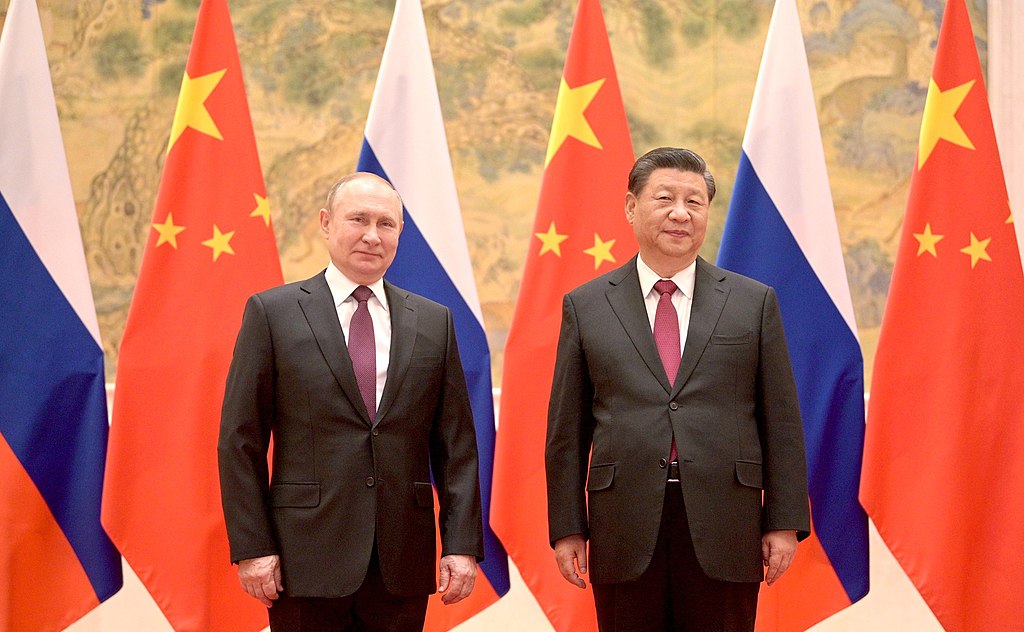 Russian President Vladimir Putin held talks in Beijing with General Secretary of the Communist Party and President of China Xi Jinping. Photo by: Presidential Executive Office of Russia, www.kremlin.ru, via WikimediaCommons
Russian President Vladimir Putin held talks in Beijing with General Secretary of the Communist Party and President of China Xi Jinping. Photo by: Presidential Executive Office of Russia, www.kremlin.ru, via WikimediaCommons
 Russian President Vladimir Putin held talks in Beijing with General Secretary of the Communist Party and President of China Xi Jinping. Photo by: Presidential Executive Office of Russia, www.kremlin.ru, via WikimediaCommons
Russian President Vladimir Putin held talks in Beijing with General Secretary of the Communist Party and President of China Xi Jinping. Photo by: Presidential Executive Office of Russia, www.kremlin.ru, via WikimediaCommonsE. Conflict in the Indo-Pacific has significant implications for Europe
China’s military growth, its worrying military-technological advances, and its aggressive regional policies have made it the United States’ pacing factor in developing defense capabilities and policies. China’s aggressive territorial claims in the South and East China Seas, and its threats to the integrity of Taiwan, present a real risk of conflict in the Indo-Pacific, including direct confrontation between China and the United States. In such a situation, critical sea-lanes of communication, maritime shipping, and European commercial interactions with China, and with Asia more broadly, would be disrupted. The interests of various European allies in the Indo-Pacific would be at risk. Opportunities would be created for Russia. US forces might not be available to adequately reinforce European allies against a simultaneous Russian military challenge. European allies would need to quickly fill those gaps. They need to plan now how they would do so.10
F. Chinese nuclear warheads and missiles can reach all parts of the North Atlantic region.
In addition, China’s nuclear developments threaten to complicate US-Russian arms control arrangements, even as Beijing refuses to enter arms control discussions. NATO efforts to encourage China to engage in nuclear arms control negotiations are important.11
G. Humanitarian and diplomatic practices concern NATO
In addition to these security risks, the interests of NATO member states are affected by Beijing’s stated ambitions and assertive behavior on other fronts, all of which NATO leaders have agreed “present systemic challenges to the rules-based international order.”12 Those challenges include gross human rights abuses, widespread diplomatic coercion and disinformation campaigns, unfair trade and investment practices, and creation of economic and technological dependencies among a range of states across Eurasia and into Africa. At the same time, NATO leaders have been careful not to label China a military adversary or an enemy. They have noted areas of potential cooperation, including global warming, pandemic control, arms control, nonproliferation, and counterterrorism. This wide array of issues beyond NATO’s immediate remit underscores the need for NATO’s efforts to be carefully coordinated with diplomatic, economic, and technology approaches organized by the European Union (EU), the G7, and other like-minded democratic partners.13
II. Addressing China’s challenges in NATO’s Strategic Concept
The Biden administration was able to harness these converging perspectives, address many of these challenges, and fashion with Allied leaders a comprehensive approach to China at the June 2022 Madrid NATO Summit. At Madrid, allies issued a new Strategic Concept, NATO’s guiding document. While the new concept declared Russia to be “the most significant and direct threat to allies’ security and to peace and stability in the Euro-Atlantic area,” for the first time in the Alliance’s history it also addressed China, whose “stated ambitions and coercive policies,” it asserted, “challenge our interests, security and values.”14 Allies singled out China’s “malicious hybrid and cyber operations” and disinformation tactics. They expressed concern over China’s efforts “to control key technological and industrial sectors, critical infrastructure, and supply chains” to create strategic dependencies. They accused China of trying to “subvert the rules-based international order,” and pointed to Beijing’s efforts to expand its nuclear capabilities and its rejection of arms control or risk reduction talks. They declared that aspects of the China-Russia partnership could undermine Alliance security.15
The Strategic Concept then lays out a framework for managing these challenges from China. NATO members assert that they will:
“work together responsibly, as Allies, to address the systemic challenges posed by the PRC to Euro-Atlantic security and ensure NATO’s enduring ability to guarantee the defence and security of Allies. We will boost our shared awareness, enhance our resilience and preparedness, and protect against the PRC’s coercive tactics and efforts to divide the Alliance. We will stand up for our shared values and the rules-based international order, including freedom of navigation.”16
The framework notes that NATO remains “open” to “constructive engagement” with China. Members also committed to enhance NATO’s strategic partnership with the EU, in part to address “the systemic challenges posed by the PRC to Euro-Atlantic security.”17 Finally, leaders underscored the importance of the Indo-Pacific for NATO, “given that developments in that region can directly affect Euro-Atlantic security.” Recognizing the important role of Japan, South Korea, Australia, and New Zealand, all of which attended a NATO summit for the first time, Alliance leaders committed to strengthen dialogue and cooperation with them and other Indo-Pacific partners.18
III. Strategic Concept follow-up meetings
In September 2022, NATO Secretary General Jens Stoltenberg met with Chinese Foreign Minister Wang Yi and called on China to use its influence with Moscow to end the war in Ukraine. He also raised concerns about Chinese military operations near Taiwan and about its human rights practices.19 That same month, NATO held its first dedicated discussion on Taiwan and the rising threats to its security from China.20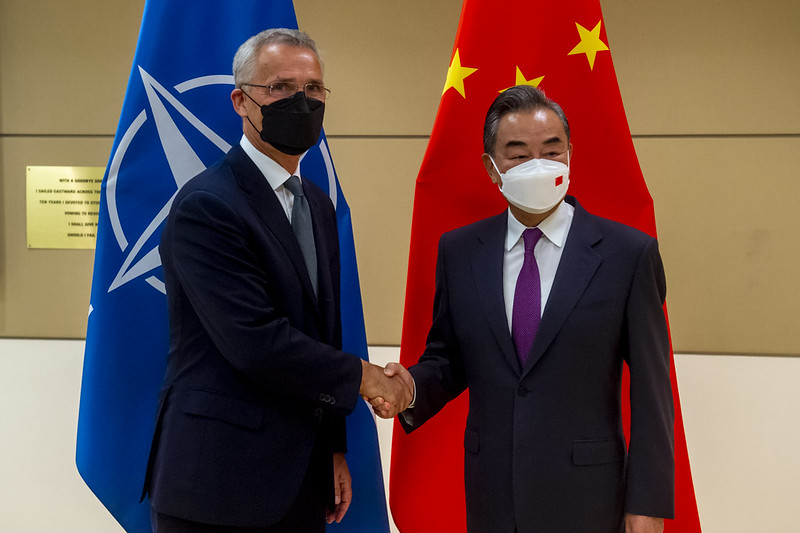 Bilateral meeting between NATO Secretary General Jens Stoltenberg and Wang Yi, Minister of Foreign Affairs of China
Bilateral meeting between NATO Secretary General Jens Stoltenberg and Wang Yi, Minister of Foreign Affairs of China
 Bilateral meeting between NATO Secretary General Jens Stoltenberg and Wang Yi, Minister of Foreign Affairs of China
Bilateral meeting between NATO Secretary General Jens Stoltenberg and Wang Yi, Minister of Foreign Affairs of ChinaPhoto by: NATO North Atlantic Treaty Organization via Flickr
In mid-November, US President Joe Biden and Chinese President Xi Jinping met for three hours in Bali, seeking to reduce tensions. While the talks were described as “blunt” by Biden, China chose to highlight their “common understanding” and their instructions to their teams to “take concrete actions to put China-US relations back on the track of steady development.” Both sides concurred that there was no need for another Cold War. Biden stressed that US policy toward Taiwan had not changed and that the United States “does not support changes in the status quo from either side,” meaning China should not use force to coerce but also that Taiwan should not unilaterally declare its independence. Both presidents underscored their opposition to Moscow’s threats to use nuclear weapons in Ukraine. They agreed to deepen constructive efforts on issues like climate change, health security, and food security.21
In late November, NATO’s foreign ministers met in Bucharest. Much of their discussion centered around the presentation of NATO’s confidential annual report of strategic concerns about China. Setting the tone, Stoltenberg said: “NATO is an Alliance of Europe and North America, but the challenges we face are global, and we must address them together in NATO.” He added that the war in Ukraine requires an assessment of “our dependencies on other authoritarian regimes, not least China, for our supply chains, technology, or infrastructure.”22 In their discussions the ministers reinforced several points made in the Strategic Concept, including China’s growing military and technological advances and its cyber and hybrid activities. They agreed to better protect critical infrastructure, supply chains of key materials, and cyber assets from undue Chinese influence or control, and on the need to coordinate export controls on technology and security reviews of Chinese investments.23 They stressed the need to increase cooperation with partners in the Indo-Pacific region and with the EU, to meet NATO resilience guidelines, and to maintain NATO’s technological lead.
In his post-meeting press conference, Stoltenberg also noted that NATO does not see China as an adversary and that it will continue to engage with China when such engagement is in NATO’s interest.24
IV. Implementing NATO’s China policy
The China policy articulated in the Strategic Concept and subsequent meetings must now be translated into action. This might be accomplished by operating on the three basic tracks laid out in the Concept: addressing the challenge, strengthening Indo-Pacific partnerships, and exploring cooperation with China where feasible. Below are recommendations for implementation.
A. Track one: Addressing the China Challenge
To begin implementing the Concept, allies should:
Enhance intelligence sharing on China, including with a view to developing a shared assessment of Beijing’s strategic goals and methods. They should create China focal points within Alliance structures, such as the international staff, the military staff, and Allied command operations headquarters (SHAPE). An annual China review by the North Atlantic Council (NAC) could direct additional responses. Speaking with one voice will be critical to ensuring this political solidarity, particularly on policy and security assistance surrounding Russia’s war in Ukraine and issues relating to transatlantic values, democracy, and human rights. Economic values should be part of this conversation. Allies should prioritize dismantling China’s 14+1 arrangement with Central and Eastern European countries.
Explore deeper coordination under Article 2 of the North Atlantic Treaty, in which they commit to promote “conditions of stability and well-being” and to “encourage economic collaboration.” Article 2 offers a framework for allies to enhance screening of foreign investment in security-related infrastructures, companies, and technologies, as well as taking other steps to protect individual allied countries from security-related dependencies on China or other relevant countries. Article 2 is also a window to more-effective cooperation with the EU on these issues, including common or complementary principles of action with regard to economic security contingencies.
Conduct an Alliance-wide review of defense supply chain dependencies on China and other potentially critical countries.25 They should update NATO’s secure telecommunications requirements for 5G and incorporate secure 5G spending and other cyber and infrastructure protections into NATO’s spending goals. They should utilize NATO-EU mechanisms to address threats to critical infrastructure, investment screening, export controls (including of dual-use technology), telecommunications, and supply chains. They should work to set standards for NATO members and partners regarding external investment in critical infrastructure, particularly if that infrastructure plays a role in NATO missions. And they should consider closer cooperation with international development finance corporations to highlight alternative investment options for critical infrastructure, especially among newer members and partners.26
Seek to limit China’s strategic partnership with Russia, including by taking advantage of Chinese concerns over Russia’s war in Ukraine, especially Putin’s nuclear bluster; continuing to distinguish between Russia as an adversary and China as a competitor; and designing incentives and disincentives to draw China away from Russia. The US National Defense Strategy’s description of Russia as an “acute” threat and China as the “pacing challenge” makes this distinction clear, and indicates that Chinese efforts to develop and maintain a long-term partnership with Russia will only keep the transatlantic community united against them.
Counter Chinese efforts to subvert the rules-based international order, especially in the global commons. This includes maximizing direct European participation in freedom of navigation operations in Asia. Allies should take united action to counter malicious Chinese cyber operations, including coordinated retaliation.
[To implement NATO’s Strategic Concept on China, NATO must] counter Chinese efforts to subvert the rules-based international order, especially in the global commons. This includes maximizing direct European participation in freedom of navigation operations in Asia.
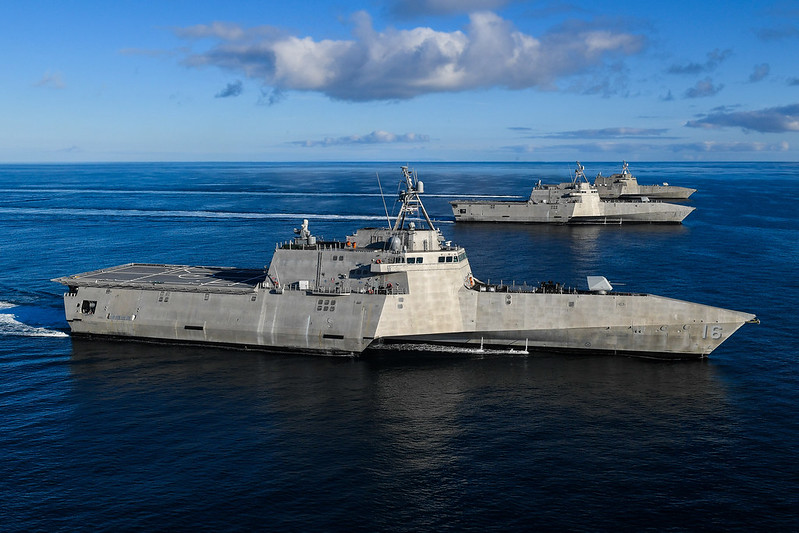 PACIFIC OCEAN (Feb. 27, 2019) The Independence variant littoral combat ships USS Tulsa (LCS 16), right, USS Manchester (LCS 14), center, and USS Independence (LCS 2), left, sail in formation in the Pacific. LCS are high-speed, agile, shallow draft, mission-focused surface combatants designed for operations in the littoral environment, yet fully capable of open ocean operations. As part of the surface fleet, LCS has the ability to counter and outpace evolving threats independently or within a network of surface combatants.
PACIFIC OCEAN (Feb. 27, 2019) The Independence variant littoral combat ships USS Tulsa (LCS 16), right, USS Manchester (LCS 14), center, and USS Independence (LCS 2), left, sail in formation in the Pacific. LCS are high-speed, agile, shallow draft, mission-focused surface combatants designed for operations in the littoral environment, yet fully capable of open ocean operations. As part of the surface fleet, LCS has the ability to counter and outpace evolving threats independently or within a network of surface combatants.Photo by: Chief Mass Communication Specialist Shannon Renfroe/Released via U.S. Pacific Fleet, Flickr
Demonstrate support for US efforts to deter war with China, but also prepare for the worst. A series of strategic games held at the level of the NAC could help allies better understand the impact of a US-Chinese war on NATO. European allies should be clear with China that they would not stand idly by should a US-China war break out. Allies can help design diplomatic approaches to defuse the Taiwan issue. And they can block technology transfers to China that could further fuel China’s military buildup.27
In the longer term, the Alliance must square a triangle of issues: maintaining confidence that the United States can adequately uphold its commitments in both the North Atlantic and the Indo-Pacific; ensuring Europe’s capacity to defend itself against Russia and manage a range of additional crises, many along its southern periphery; and addressing European aspirations for greater strategic autonomy.28 Should a conflict simultaneously break out with China in Asia and Russia in Europe, the United States may not be able to deploy adequate reinforcements to Europe. That means European allies need to be able to pick up the slack, in two ways. Over the coming decade, they should build their conventional military capabilities to a level that would provide half of the forces and capabilities, including the strategic enablers, required for deterrence and collective defense against Russian aggression. In addition, Europe should become the “first responder” to most crises along its southern periphery. European allies should develop capabilities to conduct crisis management operations without today’s heavy reliance on US enablers such as strategic lift, refueling, communications, and intelligence.29
They must develop a plan for greater European strategic responsibility to fight a major adversary without major US reinforcements, should the United States be occupied in Asia.30
B. Track two: Developing effective Indo-Pacific partnerships
The Alliance should strengthen its Asia-Pacific partners program by formalizing the process; expanding the number of Asian partners beyond Japan, the Republic of Korea, Australia, and New Zealand; and including military exercises and greater intelligence sharing on China. Consideration should be given to inviting Japan, the Republic of Korea, and New Zealand to join Australia as NATO Enhanced Opportunities Partners. Varying levels of enhanced military cooperation could be considered, from information sharing and joint exercises to joint operational planning or joint command centers.31 An Indo-Pacific–NATO council or commission could be established as a forum by which the Alliance and close partners from the region can identify cooperative activities and share assessments about evolving security challenges, including from China.32 NATO liaison offices could be created in Tokyo and Seoul to encourage greater defense cooperation.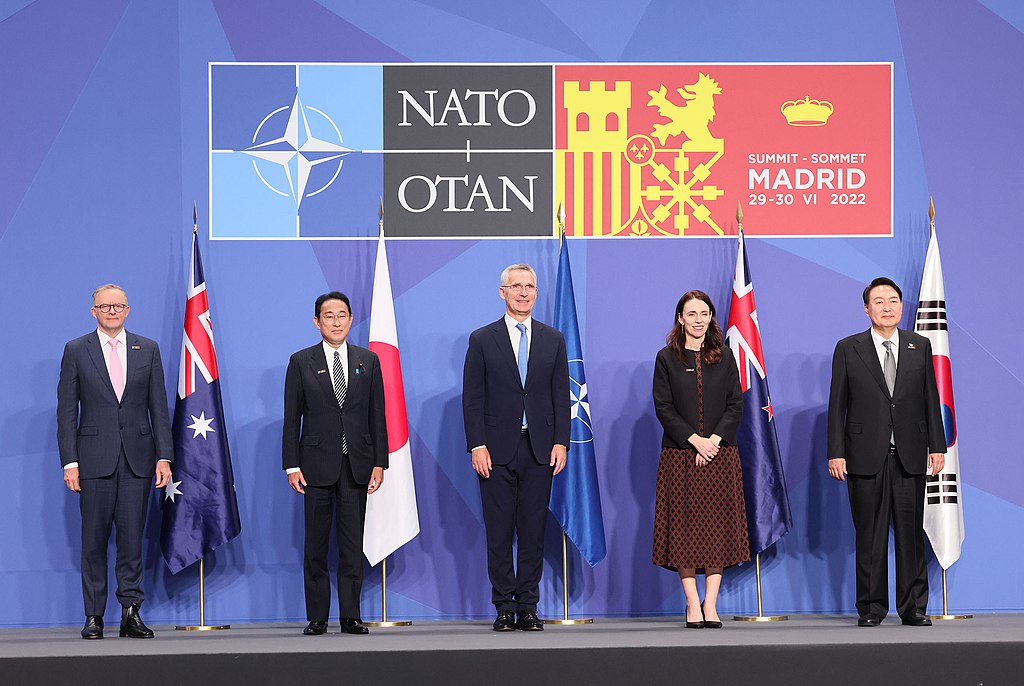 On June 29, 2022 (local time), Prime Minister Kishida attended a photo session of the NATO+AP4 members.
On June 29, 2022 (local time), Prime Minister Kishida attended a photo session of the NATO+AP4 members.
 On June 29, 2022 (local time), Prime Minister Kishida attended a photo session of the NATO+AP4 members.
On June 29, 2022 (local time), Prime Minister Kishida attended a photo session of the NATO+AP4 members.Centers of Excellence (COE) could be established in the Indo-Pacific that follow the model of current COEs in Helsinki and Bucharest, which are not formal NATO entities but are open to participation by a host of actors, including NATO. Private sector actors could also participate. Priority issues are a) addressing security challenges arising from economic interdependencies and technological advances, and b) security challenges related to competition in the global commons.33
Building on the Indo-Pacific Quad, allies should consider exploring an ad hoc, issue-by-issue dialogue with India, which has not indicated interest in a deeper partnership with NATO yet shares overlapping concerns regarding Chinese actions and intentions.34
C. Track three: Exploring constructive engagement with Beijing
As allies craft these approaches, they should also design a plan for constructive engagement with China. This might include creation of a NATO-China council, with annual or semiannual meetings at NAC level, to develop a strategic dialogue and explore potential areas of cooperation such as the security implications of climate change and pandemic management.
As the United States and China pursue the agenda for cooperation discussed by Biden and Xi in Bali, NATO should seek to participate in those areas where appropriate and to initiate parallel activities where possible.
These areas could include NATO efforts to develop confidence-building measures, crisis management procedures, rules of the road, and incident management procedures to cover the increased risk that flow from the fact that Chinese and NATO military forces will operate in closer proximity with one another.
NATO nations have a particular opportunity to weigh in with Beijing with regard to Russia’s war on Ukraine. China has walked a fine line, parroting Moscow’s justification for the war but providing little material support for Putin’s war effort. Beijing is clearly uneasy with the war. With Europe’s help, there is a real opportunity for greater NATO cooperation with Beijing on this issue.
At some point, the United States and China will need to develop a strategic stability dialogue aimed at both crisis stability and escalation stability. Nuclear arms control issues and confidence building measures will need to be addressed. Close coordination between the United States and NATO will be needed as such a dialogue proceeds.
V. Conclusion
At Madrid, Allied leaders essentially declared the Indo-Pacific and European theaters to be increasingly linked. An ambitious effort to implement the Strategic Concept’s plan for China is needed. It will take time, and immediate crises like Putin’s war on Ukraine will have priority. But NATO cannot let the agenda for implementation slip. Priorities should be set. The Alliance should start with an agreed intelligence assessment and new bureaucratic focal points in NATO headquarters and SHAPE to implement the plan. Establishing mechanisms to avoid further dependencies is a top priority, as is establishing a formal defense partnership between NATO and Indo-Pacific countries. Rapid establishment of a NATO-China council should also be a top priority. This much can be accomplished within a year.
No comments:
Post a Comment